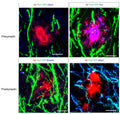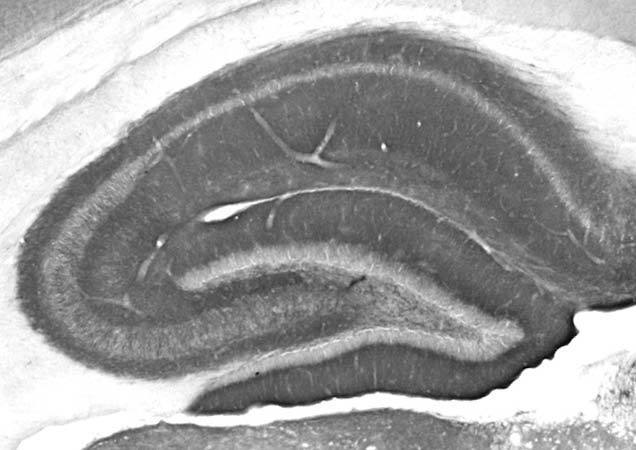Ships: 1-2 business days
Product Specific References for Applications and Species
- Immunocytochemistry: Mouse | Rat
- ImmunoGold Labeling: Rat
- Immunohistochemistry: Mouse
- Western Blot: Human | Mouse | Rabbit| Rat
| Immunocytochemistry: Mouse | ||
| PMID | Dilution | Publication |
| 32275651 | not listed | Willems, J., et al. 2020. ORANGE: A CRISPR/Cas9-based genome editing toolbox for epitope tagging of endogenous proteins in neurons. PLoS Biology, e3000665. |
| 29478916 | 1:500 | Mikhaylova, M., et al. 2018. Caldendrin Directly Couples Postsynaptic Calcium Signals to Actin Remodeling in Dendritic Spines. Neuron, 1110-1125. |
| 24153177 | not listed | Han, K., et al. 2013. SHANK3 overexpression causes manic-like behaviour with unique pharmacogenetic properties. Nature, 72-77. |
| 21994763 | 1:500 | Berkel, S., et al. 2012. Inherited and de novo SHANK2 variants associated with autism spectrum disorder impair neuronal morphogenesis and physiology. Human molecular genetics, 344-357. |
| Immunocytochemistry: Rat | ||
| PMID | Dilution | Publication |
| 30524232 | 1:100 | Ha, H., et al. 2018. Shank and Zinc Mediate an AMPA Receptor Subunit Switch in Developing Neurons. Frontiers in molecular neuroscience, 405. |
| 29735556 | 1:1000 | Campbell, M.K., et al. 2018. USP8 Deubiquitinates SHANK3 to Control Synapse Density and SHANK3 Activity-Dependent Protein Levels. The Journal of neuroscience : the official journal of the Society for Neuroscience, 5289-5301. |
| 29478916 | 1:500 | Mikhaylova, M., et al. 2018. Caldendrin Directly Couples Postsynaptic Calcium Signals to Actin Remodeling in Dendritic Spines. Neuron, 1110-1125. |
| 26547831 | 1:400 | MacGillavry, H., et al. 2016. Shank-cortactin interactions control actin dynamics to maintain flexibility of neuronal spines and synapses. The European journal of neuroscience, 179-193. |
| 24239382 | not listed | Baple, E., et al. 2014. Mutations in KPTN cause macrocephaly, neurodevelopmental delay, and seizures. American journal of human genetics, 87-94. |
| 21795692 | not listed | Verpelli, C., et al. 2011. Importance of Shank3 protein in regulating metabotropic glutamate receptor 5 (mGluR5) expression and signaling at synapses. The Journal of biological chemistry, 34869-34850. |
| ImmunoGold Labeling: Rat | ||
| PMID | Dilution | Publication |
| 32238193 | 1:200 | Tao-Cheng, J.H, et al. 2020. Activity-dependent redistribution of CaMKII in the postsynaptic compartment of hippocampal neurons. Molecular brain, 53. |
| 26665164 | 1:200 | Tao-Cheng, J.H., et al. 2015. Depolarization of Hippocampal Neurons Induces Formation of Nonsynaptic NMDA Receptor Islands Resembling Nascent Postsynaptic Densities. eNeuro, ENEURO.0066-15.20015. |
| 26215919 | 1:50 | Farley, M., et al. 2015. Electron tomographic structure and protein composition of isolated rat cerebellar, hippocampal and cortical postsynaptic densities. Neuroscience, 286-301. |
| 25775468 | 1:200 | Tao-Cheng, J.H., et al. 2015. Differential distribution of Shank and GKAP at the postsynaptic density. PLoS one, e0118750. |
| 20347015 | 1:200 | Tao-Cheng, J.H., et al. 2010. Activity induced changes in the distribution of Shanks at hippocampal synapses. Neuroscience, 44882. |
| Immunohistochemistry: Mouse | ||
| PMID | Dilution | Publication |
| 37667395 | 1:300-1:1000 | Jang, J, et al. 2023. Abnormal accumulation of extracellular vesicles in hippocampal dystrophic axons and regulation by the primary cilia in Alzheimer's disease. Acta Neuropathologica Communications, 142. |
| 28134307 | 1:500 | Joshi, P., et al. 2017. Fingolimod Limits Acute Aβ Neurotoxicity and Promotes Synaptic Versus Extrasynaptic NMDA Receptor Functionality in Hippocampal Neurons. Scientific reports, 41734. |
| 25637745 | not listed | Braude, J., et al. 2015. Deletion of Shank1 has minimal effects on the molecular composition and function of glutamatergic afferent postsynapses in the mouse inner ear. Hearing research, 52-64. |
| Western Blot: Human | ||
| PMID | Dilution | Publication |
| 25560758 | not listed | Peykov, S., et al. 2015. Identification and functional characterization of rare SHANK2 variants in schizophrenia. Molecular psychiatry, 1489-1498. |
| Western Blot: Mouse | ||
| PMID | Dilution | Publication |
| 24751538 | not listed | Schneider, K., et al. 2014. ProSAP1 and membrane nanodomain-associated syndapin I promote postsynapse formation and function. The Journal of cellular biology, 197-215. |
| 24153177 | not listed | Han, K., et al. 2013. SHANK3 overexpression causes manic-like behaviour with unique pharmacogenetic properties. Nature, 72-77. |
| 22338020 | not listed | Qian, H., et al. 2012. β2-Adrenergic receptor supports prolonged theta tetanus-induced LTP. Journal of neurophysiology, 2703-2712. |
| 21551375 | not listed | Xie, M., et al. 2011. Inactivation of multidrug resistance proteins disrupts both cellular extrusion and intracellular degradation of cAMP. Molecular pharmacology, 281-293. |
| Western Blot: Rabbit | ||
| PMID | Dilution | Publication |
| 22338020 | not listed | Qian, H., et al. 2012. β2-Adrenergic receptor supports prolonged theta tetanus-induced LTP. Journal of neurophysiology, 2703-2712. |
| Western Blot: Rat | ||
| PMID | Dilution | Publication |
| 30524232 | 1:1000 | Ha, H., et al. 2018. Shank and Zinc Mediate an AMPA Receptor Subunit Switch in Developing Neurons. Frontiers in molecular neuroscience, 405. |
| 29735556 | 1:1000 | Campbell, M.K., et al. 2018. USP8 Deubiquitinates SHANK3 to Control Synapse Density and SHANK3 Activity-Dependent Protein Levels. The Journal of neuroscience : the official journal of the Society for Neuroscience, 5289-5301. |
| 27144302 | 1:1000 | Tao-Cheng, J.H., et al. 2016. Zinc Stabilizes Shank3 at the Postsynaptic Density of Hippocampal Synapses. PLoS one, e0153979. |
| 21795692 | not listed | Verpelli, C., et al. 2011. Importance of Shank3 protein in regulating metabotropic glutamate receptor 5 (mGluR5) expression and signaling at synapses. The Journal of biological chemistry, 34869-34850. |
| 20347015 | 1:1000 | Tao-Cheng, J.H., et al. 2010. Activity induced changes in the distribution of Shanks at hippocampal synapses. Neuroscience, 44882. |



![Immunoblots on brain membranes prepared from whole rat (RBM) and mouse (MBM) brain, and from human cerebral cortex [HBM(Cx)] and hippocampus [HBM(H)].](http://www.antibodiesinc.com/cdn/shop/products/validation-image-73-088-n23b-6-wb-2_120x120.jpg?v=1626904249)



